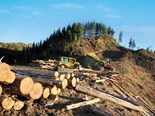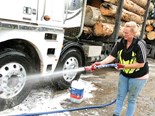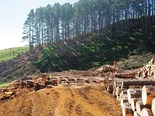Tolaga Bay and Gisborne flooding—who is to blame?
After heavy rain and flooding in Tolaga Bay and Gisborne left millions of tonnes of forestry debris, destroying roads, home, bridges, and more, Patrick Cox looks at who should be held responsible for the disaster.
The recent rainfall in the Tolaga Bay and Gisborne area bought down tens of thousands of tonnes of forest debris, destroying homes, roads, bridges, and anything else that got in its way. My immediate response was someone has to be held responsible for this disaster, and at the top of my list was the plantation owners, but after a bit of soul searching and research, I concluded that no one group or person could be held responsible.

Unbeknown to us, the problem started 30 years ago when the forest was planted. I remember going on a holiday to Lottin Point up on the East Cape back in the ’80s and watched the development of the steep inhospitable country around Te Kaha and the like being developed and planted in pines. Did anyone stop and think then how we would harvest these forests or would we worry about it when the time comes?
We plant marginal land because it is not much use for anything else and planting pines is a good alternative to getting cash back for land that is otherwise useless. The problem with planting marginal land is that harvesting, roading, and planning costs go through the roof.
So who is to blame? We can start with the Central Government, who continually encouraged landowners to plant pines. Private foresters purchased many farms and covered them completely with pines, right up to the edge of rivers and lakes with no protective nature strip between the trees and the water. We also saw this with the farmers after they took a battering from the environmentalists and the Government about the ever-increasing problem of the volume of effluent polluting our waterways. Local and regional councils would have approved the planting of these forests and also in most cases signed off on the harvesting plan, and so they, too, should accept part of the blame.
I had a conversation with a farmer recently who had finished harvesting his own trees that had been planted on marginal land on his farm. I asked why he did not take 20 acres of prime land for planting his trees, suggesting that all his roading and compliance costs would have been considerably less and he would have made more money.
The response was one I had not considered. According to the farmer, his bank determined where he could plant his trees. When he presented his plan to them, they asked how many stock units he would lose. I ran this past a mate of mine who is an ex-rural banker, and the answer was that stock units are related to cash flow and monthly repayments. Any reduction in stock units would have a serious effect on cash flow; hence planting would take place on marginal land only.
So let’s not forget that the banks and financial institutions that have bank-rolled forest investment have a part in the blame game as well.
The implementation of the Resource Management Act (RMA) has failed to protect our people and waterways. The fact that a huge percentage of logging waste was also washed out to sea and is causing navigation hazards for local and recreational fishermen and coastal freighters should also be a big concern to us. Eventually, a big percentage of logging debris that does not sink will wash up on our beaches for many months to come.
Now, we have a waste problem with our forest that we have to try and fix. The introduction of the National Environmental Standards for Plantation Forestry under the RMA, which came into effect on 1 May 2018, it is finally a step in the right direction. The problem here is the horse has already bolted but it is good to see we have a new plan to stop this happening again, and we won’t see the results of this for plantations planted after 1 May until they are ready to harvest in 30 years.
But how do we fix the current problem, as this will go on until all marginal land is logged. I think all current plantation forest that are planted right up to the edge of any waterway should have a 100m nature strip left standing even if is just pines. This will act as a sieve or blotting paper to stop the debris.
You also have to ask the question about why we do not burn the waste. We used to always burn off before replanting. If nature strips were enforced now, who would pay compensation for the many thousand of dollars for the trees left standing. Maybe some marginal blocks should not be logged at all. Someone is going to have to make a hard call because what happened in Tolaga Bay is just a tip of the iceberg and it will happen again.
Under the new National Environmental Standards for Plantation Forestry, there will be conditions to manage setbacks when planting next to rivers, lakes, wetlands, and coastal areas to protect against erosion and sedimentation from afforestation. There will need to be management plans for earthworks, quarrying, and harvesting to identify environmental risks and how they will be managed. Forest owners will also need to identify and maintain stormwater and sediment control before harvesting will be permitted; if they cannot meet the above, they will need to seek resource consent from the council.
If forest operators can meet the conditions, the activity is permitted. Here is the final part of the jigsaw puzzle: if councils have granted resource consent and logging debris end up in our waterways, should the council not be held to task? The loggers are just a pawn in the blame game and they have no choice but to log what they have been asked to do under their contractual obligation to the forest owners, and I am completely sure that harvest operators apply best logging practice to their harvest extraction.
Maybe NZ First MP Shane Jones and his billion-dollar regional forestry fund should address the current problems in forestry before planting another couple of billion trees to escalate the current problem. But we might not have to worry because he has not come up with a plan on how to get the workforce to harvest these trees, and they will probably get left standing for a lot longer than normal harvest practices. There is one final question: why do we leave so much wood behind? Could this not be extracted for pulp or chipping? Would a mobile chipping plant make sense going in after the loggers have finished and chip all the waste? After all, we do export wood chip.
Keep up to date in the industry by signing up to Deals on Wheels' free newsletter or liking us on Facebook.
















